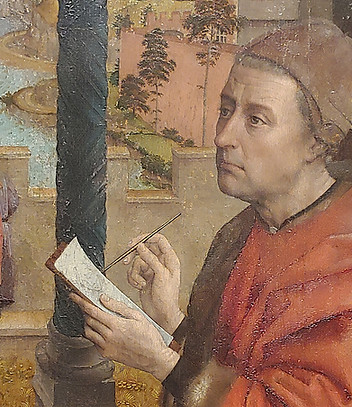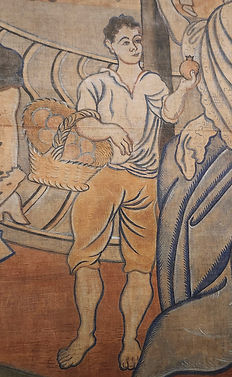What do you see when you look at a painting? You see the subject and the style of the work but also the materials and technologies used to create it and the traces of everything that has happened to it.
Professional paintings conservator Jean Dommermuth considers how all of those factors contribute to what a painting is. You don’t need to know anything about art history to enjoy this podcast, but no matter what, you’ll never look at a painting the same way again.
What is the physical structure of a painting, and how does that relate to how a painting looks in person?
Click image for related content
Rembrandt, Aristotle with a Bust of Homer, 1653, oil on canvas, 56 1/2 x 53 3/4 inches (143.5 x 136.5 cm)
The Metropolitan Museum of Art, New York
What clues about a painting's materials and history can you find just by looking?
Click image for related content
Botticelli, The Birth of Venus, 1480s, tempera on canvas, 72 1/2 x 112 1/2 inches (184.5 x 285.5 cm)
Uffizi Galleries, Florence
How have modern painters explored what a painting can be?
Click image for related content
Frank Stella, Haines City, 1963, alkyd on canvas, 99 × 99 inches (251.5 × 251.5 cm)
The Metropolitan Museum of Art, New York
How did European painters and patrons before about 1400 understand what paintings were, and how did that affect how they were made?
Click image for related content
Bernardo Daddi, Virgin And Child With A Goldfinch, 1345-1348, tempera on panel , 38 11/16 X 21 7/8 Inches (98.2 X 55.6 cm)
Isabella Stewart Gardner Museum, Boston
How does a tree become a support for a painting, and how does the memory of its life in the forest affect that support? A look at Early Italian panels.
Click image for related content
Bernardo Daddi, Santa Reparata Before the Emperor Decius, c1340, tempera and gold on panel, 12 ¾ x 16 in (32.4 x 40.6 cm)
The Metropolitan Museum of Art, New York
How did painters turn natural materials from animal and mineral sources into the perfect preparation for their panel paintings? A look at Early Italian gesso grounds.
Click image for related content
Simone Martini, Virgin and Child with Saints Helen, Paul, Dominic, Stephen (?), and a Dominican Nun, c 1325
Tempera and tooled gold on panel, 13 1/8 x 10 x ¾ in (33.4 x 25.4 x 1.9 cm)
Isabella Stewart Gardner Museum, Boston
How were the gold backgrounds of Early Italian paintings created, and how have they changed over time?
Click image for related content
Master of the Sienese Straus Madonna, Virgin and Child, c 1340-50
Tempera and gold leaf on panel, 32 1/8 × 17 3/4 in. (81.6 × 45.1 cm)
Museum of Fine Arts, Houston
What are the components of the paint used by Early Italian painters, how did they use it, and how has it changed over the centuries?
Click image for related content
Simone Martini, Saint Ansanus, ca. 1326
Tempera on wood, gold ground, 22 5/8 x 15 in. (57.5 x 38.1 cm)
The Metropolitan Museum of Art, New York
How did Early Italian painters combine gold and paint to imitate luxury textiles?
Click image for related content
Master of the Sienese Straus Madonna, Virgin and Child, c 1340-50 (detail)
Tempera and gold leaf on panel, 32 1/8 × 17 3/4 in. (81.6 × 45.1 cm)
Museum of Fine Arts, Houston
How do modern and contemporary paintings reflect some of the physical aspects of Early Italian paintings? Some thoughts about engaged frames and the use of gold leaf.
Click image for related content
Dread Scott, I Wish I Knew How It Would Feel to Be Free, 2023
Body print, screenprint, gold leaf, tar and feathers on canvas
84 x 68 in (213.4 x 172.7 cm)
What's the story of the Cimabue Crucifix at Santa Croce, Florence? From the thirteenth century until 1966.
Click image for related content
Cimabue, Crucifix (detail), c. 1265
Tempera on wood panel, 176 x 150 in (448 x 390 cm)
Basilica di Santa Croce, Florence
What's the story of the Cimabue Crucifix at Santa Croce, Florence? From 1966 until now.
Click image for related content
Cimabue, Crucifix (detail), c. 1265
Tempera on wood panel, 176 x 150 in (448 x 390 cm)
Basilica di Santa Croce, Florence
How do Early Netherlandish paintings differ from Early Italian paintings - in how they look, what they mean, and what they are?
Click image for related content
Workshop of Robert Campin, Annunciation Triptych (Merode Altarpiece), ca. 1427–32
Oil on oak, overall (open): 25 3/8 x 46 3/8 in. (64.5 x 117.8 cm)
The Cloisters, The Metropolitan Museum of Art, New York
Why are the oak panels of Early Netherlandish paintings good supports, and what can they tell us?
Click image for related content
Workshop of Robert Campin, Annunciation Triptych (Merode Altarpiece) detail, ca. 1427–32
Oil on oak, overall (open): 25 3/8 x 46 3/8 in. (64.5 x 117.8 cm)
The Cloisters, The Metropolitan Museum of Art, New York
How were the underdrawings of Early Netherlandish paintings made and how can we see them?
Click image for related content
Rogier van der Weyden, Saint Luke Drawing the Virgin (detail), c 1435 – 40
Oil and tempera on panel, 54 1/8 x 43 5/8 in (137.5 x 110.8 cm)
Museum of Fine Arts, Boston
How does the use of different media affect the look of paint?
Click image for related content
Jan Van Eyck, The Arnolfini Marriage, 1434
Oil on oak, 32 14 x 23 1/2 in (82.2 x 60 cm) (detail)
National Gallery, London
How did Early Netherlandish painters use different materials to create different kinds of landscapes, and how have those paintings changed over time?
Click image for related content
Jan van Eyck, Saint Francis of Assisi Receiving the Stigmata, 1430-1432
Oil on vellum on panel, 5 x 5 ¾ in (12.7 x 14.5 cm) (detail)
Philadelphia Museum of Art
What is the Ghent Altarpiece, how was it created, and what changes did it undergo in the first 125 years of its existence?
Click image for related content
Jan and Hubert van Eyck, The Ghent Altarpiece: The Just Judges (detail,) 1432
Oil on oak, open dimensions 11 ft 6 in x 15 ft (350 x 460 cm)
Current location unknown.
What happened to the Ghent Altarpiece between 1566 and 1934?
Click image for related content
Jan and Hubert van Eyck, The Ghent Altarpiece: The Just Judges (detail,) 1432
Oil on oak, open dimensions 11 ft 6 in x 15 ft (350 x 460 cm)
X Radiograph taken in 1927
Current location unknown.
Where is the Just Judges panel of the Ghent Altarpiece?
Click image for related content
Jan and Hubert van Eyck, The Ghent Altarpiece: The Just Judges (detail,) 1432
Oil on oak, open dimensions 11 ft 6 in x 15 ft (350 x 460 cm)
Photograph taken after 1934 theft
What's the story of the painting of the Just Judges panel now on display in Ghent?
Click image for related content
Jef Van der Veken, The Just Judges (after Jan and Hubert Van Eyck,) 1939 - 51
What is the canvas of a canvas painting, and why and how was it used?
Click image for related content
Justus of Ghent, The Adoration of the Magi (detail), c 1475
Distemper on canvas, 43 x 63 in (109.2 x 160 cm)
The Metropolitan Museum of Art, New York
How does paint made from animal glue and different blue pigments work, look, and age?
Click image for related content
Dirk Bouts, The Entombment, (detail) c 1450s
Glue tempera on canvas, 34 ½ x 29 in (87.5 × 73.6 cm)
National Gallery, London
What can be done to reinforce a degraded canvas support of a painting, and how can that change that painting's look?
Click image for related content
Justus of Ghent, The Adoration of the Magi, c 1475
Distemper on canvas, 43 x 63 in (109.2 x 160 cm)
The Metropolitan Museum of Art, New York
How have natural aqueous media been used over the centuries, including by one of the most famous artists of the 20th century?
Click image for related content
Pablo Picasso, Le Tricorne, 1919 (detail)
Glue tempera on canvas, approximately 20 ft 8 in x 18 ft 11 in (629 x 577 cm)
The New York Historical Society
How did Venetian painters of the 16th century use canvas supports and oil medium to create a new kind of painting?
Click image for related content
Titian, The Flaying of Marsyas, 1570s (detail)
Oil on canvas, 86 5/8 × 80 5/16 in. (220 × 204 cm)
Archidiocese Olomouc, Kroměříž, Czech Republic
How did 16th century Venetian painters vary their ground layers to create different effects?
Click image for related content
Titian, Diana and Actaeon, 1556-9 (detail)
Oil on canvas, 72 ½ x 79 ½ in (184.5 × 202.2 cm)
National Gallery, London and National Galleries of Scotland



























